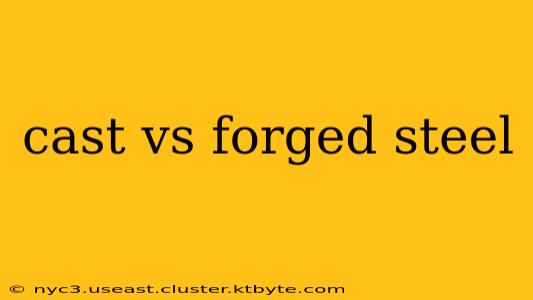Choosing between cast and forged steel can significantly impact the performance and lifespan of your project. This comprehensive guide delves into the key differences between these two steel production methods, helping you make an informed decision based on your specific needs. We'll explore their properties, applications, and cost considerations to give you a clear understanding of which option is best suited for your application.
Understanding the Manufacturing Processes
The fundamental difference between cast and forged steel lies in their manufacturing processes:
Cast Steel:
Cast steel is created by pouring molten steel into a mold. This mold, which can be made from sand, metal, or other materials, shapes the molten steel as it cools and solidifies. This process allows for the creation of complex shapes and intricate designs that would be difficult or impossible to achieve through forging.
Key Characteristics of Cast Steel:
- High internal stress: The rapid cooling process can lead to internal stresses within the material, potentially affecting its durability and longevity.
- Porosity: Cast steel can exhibit some porosity (tiny holes) depending on the casting process and material, which can reduce its strength and fatigue resistance.
- Cost-effective for complex shapes: The ability to create complex shapes economically makes casting attractive for intricate designs.
Forged Steel:
Forged steel is made by shaping a heated piece of steel using compressive forces. This process, typically involving hammers or presses, refines the steel's grain structure, resulting in a denser and stronger material. Forging can involve a variety of techniques, each suited to different shapes and sizes.
Key Characteristics of Forged Steel:
- Superior strength and durability: The forging process aligns the steel's grain structure, creating a denser material with enhanced strength, toughness, and fatigue resistance.
- Improved machinability: The refined grain structure of forged steel makes it easier to machine and finish.
- Higher cost: Forging is generally a more expensive process than casting, especially for complex shapes.
Cast Steel vs. Forged Steel: A Head-to-Head Comparison
| Feature | Cast Steel | Forged Steel |
|---|---|---|
| Manufacturing Process | Pouring molten steel into a mold | Shaping heated steel using compressive forces |
| Strength & Durability | Lower | Higher |
| Grain Structure | Coarse | Fine, aligned |
| Cost | Generally lower | Generally higher |
| Complexity of Shapes | Can produce highly complex shapes | More challenging for complex shapes |
| Internal Stress | Higher | Lower |
| Porosity | Potentially higher | Lower |
| Machinability | Can be challenging | Easier |
| Fatigue Resistance | Lower | Higher |
Applications of Cast and Forged Steel
The choice between cast and forged steel often depends on the specific application and its requirements:
Cast Steel Applications:
- Automotive parts: Engine blocks, cylinder heads, transmission cases.
- Plumbing fittings: Valves, pipes, flanges.
- Industrial machinery: Housings, frames, components requiring complex shapes.
- Art and decorative items: Sculptures, architectural elements.
Forged Steel Applications:
- Critical structural components: Bridges, cranes, pressure vessels.
- High-strength fasteners: Bolts, nuts, screws.
- Hand tools: Wrenches, hammers, axes.
- Aerospace components: Landing gear, engine parts.
Conclusion: Making the Right Choice
Selecting between cast and forged steel hinges on a careful consideration of several factors: required strength, complexity of design, cost constraints, and the overall performance expectations of the final product. While cast steel offers cost-effectiveness for intricate shapes, forged steel provides superior strength and durability for applications demanding high performance and reliability. Understanding these key differences will empower you to choose the ideal steel type for your specific needs.

